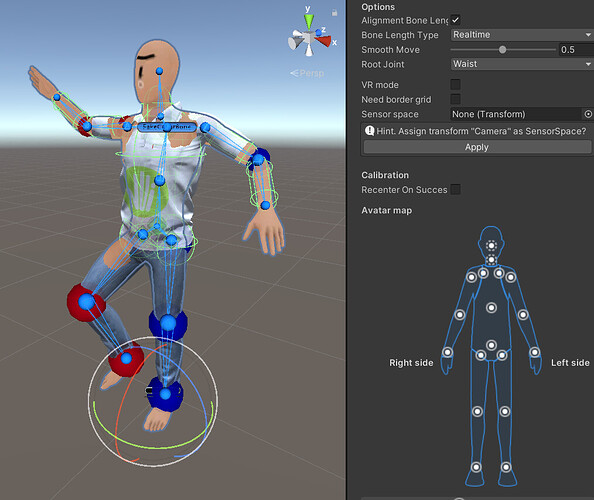Hi,
you may set model in t-pose, then at Start save joints’ initial rotations and when updating set rotations as (rotation from sensor) * (initial rotation).
Here’s script we use in one of our projects to do this:
[code]using UnityEngine;
using System.Collections;
using System.Collections.Generic;
public class ModelAvatar : MonoBehaviour
{
[SerializeField]Transform headTransform;
[SerializeField]float lerpFactor = 0.5f;
nuitrack.JointType[] availableJoints;
Dictionary<nuitrack.JointType, GameObject> joints;
Dictionary<nuitrack.JointType, Quaternion> prevOrientations;
Dictionary<nuitrack.JointType, Quaternion> baseRotationOffsets;
[SerializeField]GameObject
basePivot,
torso,
hipLeft,
hipRight,
kneeLeft,
kneeRight,
shoulderLeft,
shoulderRight,
elbowLeft,
elbowRight,
collarLeft,
collarRight;
void Start ()
{
availableJoints = new nuitrack.JointType[]
{
nuitrack.JointType.Torso,
nuitrack.JointType.LeftCollar,
nuitrack.JointType.RightCollar,
nuitrack.JointType.LeftShoulder,
nuitrack.JointType.RightShoulder,
nuitrack.JointType.LeftElbow,
nuitrack.JointType.RightElbow,
//nuitrack.JointType.LeftWrist,
//nuitrack.JointType.RightWrist,
nuitrack.JointType.LeftHip,
nuitrack.JointType.RightHip,
nuitrack.JointType.LeftKnee,
nuitrack.JointType.RightKnee,
//nuitrack.JointType.LeftAnkle,
//nuitrack.JointType.RightAnkle
};
prevOrientations = new Dictionary<nuitrack.JointType, Quaternion>();
for (int i = 0; i < availableJoints.Length; i++)
{
prevOrientations.Add(availableJoints[i], Quaternion.identity);
}
joints = new Dictionary<nuitrack.JointType, GameObject>();
joints.Add(nuitrack.JointType.Torso, torso);
joints.Add(nuitrack.JointType.LeftCollar, collarLeft);
joints.Add(nuitrack.JointType.RightCollar, collarRight);
joints.Add(nuitrack.JointType.LeftShoulder, shoulderLeft);
joints.Add(nuitrack.JointType.RightShoulder, shoulderRight);
joints.Add(nuitrack.JointType.LeftElbow, elbowLeft);
joints.Add(nuitrack.JointType.RightElbow, elbowRight);
joints.Add(nuitrack.JointType.LeftHip, hipLeft);
joints.Add(nuitrack.JointType.RightHip, hipRight);
joints.Add(nuitrack.JointType.LeftKnee, kneeLeft);
joints.Add(nuitrack.JointType.RightKnee, kneeRight);
baseRotationOffsets = new Dictionary<nuitrack.JointType, Quaternion>();
baseRotationOffsets.Add(nuitrack.JointType.Torso, torso.transform.rotation);
baseRotationOffsets.Add(nuitrack.JointType.LeftCollar, collarLeft.transform.rotation);
baseRotationOffsets.Add(nuitrack.JointType.RightCollar, collarRight.transform.rotation);
baseRotationOffsets.Add(nuitrack.JointType.LeftShoulder, shoulderLeft.transform.rotation);
baseRotationOffsets.Add(nuitrack.JointType.RightShoulder, shoulderRight.transform.rotation);
baseRotationOffsets.Add(nuitrack.JointType.LeftElbow, elbowLeft.transform.rotation);
baseRotationOffsets.Add(nuitrack.JointType.RightElbow, elbowRight.transform.rotation);
baseRotationOffsets.Add(nuitrack.JointType.LeftHip, hipLeft.transform.rotation);
baseRotationOffsets.Add(nuitrack.JointType.RightHip, hipRight.transform.rotation);
baseRotationOffsets.Add(nuitrack.JointType.LeftKnee, kneeLeft.transform.rotation);
baseRotationOffsets.Add(nuitrack.JointType.RightKnee, kneeRight.transform.rotation);
}
void FixedUpdate ()
{
JointsUpdate();
}
public Vector3 GetJointPosition(nuitrack.JointType joint)
{
return joints[joint].transform.position;
}
public Transform GetJointTransform(nuitrack.JointType joint)
{
return joints[joint].transform;
}
static Quaternion sensorOffset = Quaternion.Euler(0f, 0f, 0f);
static Vector3 mirrorScale = new Vector3(-1f, 1f, -1f);
void JointsUpdate()
{
if (NuitrackManager.CurrentUser != 0)
{
Vector3 torsoPos = 0.001f * (TPoseCalibration.SensorOrientation * Vector3.Scale(NuitrackManager.CurrentSkeleton.GetJoint(nuitrack.JointType.Torso).ToVector3(), mirrorScale));
Vector3 newTorsoPos = new Vector3(torsoPos.x, basePivot.transform.position.y, torsoPos.z);
basePivot.transform.position = newTorsoPos;
for (int i = 0; i < availableJoints.Length; i++)
{
nuitrack.Joint joint = NuitrackManager.CurrentSkeleton.GetJoint(availableJoints[i]);
Quaternion jointOrient = TPoseCalibration.SensorOrientation * (joint.ToQuaternionMirrored() * sensorOffset);
prevOrientations[availableJoints[i]] = Quaternion.Slerp(prevOrientations[availableJoints[i]], jointOrient, lerpFactor);
joints[availableJoints[i]].transform.rotation = prevOrientations[availableJoints[i]] * baseRotationOffsets[availableJoints[i]];
}
}
}
}
[/code]
and extension methods used:
using UnityEngine;
using System.Collections;
public static class NuitrackUtils
{
public static Vector3 ToVector3(this nuitrack.Joint joint)
{
return new Vector3(joint.Real.X, joint.Real.Y, joint.Real.Z);
}
public static Quaternion ToQuaternion(this nuitrack.Joint joint)
{
//Vector3 jointRight = new Vector3( joint.Orient.Matrix[0], joint.Orient.Matrix[3], joint.Orient.Matrix[6] ); //X(Right)
Vector3 jointUp = new Vector3( joint.Orient.Matrix[1], joint.Orient.Matrix[4], joint.Orient.Matrix[7] ); //Y(Up)
Vector3 jointForward = new Vector3( joint.Orient.Matrix[2], joint.Orient.Matrix[5], joint.Orient.Matrix[8] ); //Z(Forward)
return Quaternion.LookRotation(jointForward, jointUp);
}
public static Quaternion ToQuaternionMirrored(this nuitrack.Joint joint)
{
//Vector3 jointRight = new Vector3( joint.Orient.Matrix[0], -joint.Orient.Matrix[3], joint.Orient.Matrix[6] ); //X(Right)
Vector3 jointUp = new Vector3( -joint.Orient.Matrix[1], joint.Orient.Matrix[4], -joint.Orient.Matrix[7] ); //Y(Up)
Vector3 jointForward = new Vector3( joint.Orient.Matrix[2], -joint.Orient.Matrix[5], joint.Orient.Matrix[8] ); //Z(Forward)
return Quaternion.LookRotation(jointForward, jointUp);
}
}
Best regards,
Yuriy

